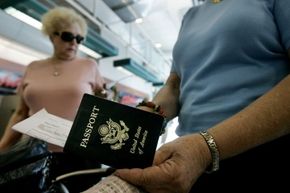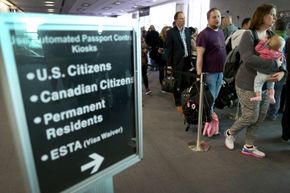One hot day in the mid-1800s, Josef Victor von Scheffel was walking along the east bank of the Rhine when the idea struck him to do a little skinny-dipping. Unfortunately for the young man, who would later become a German writer of some fame, the current flowed far faster than he expected. It took all his strength to fight through the water and, confused, he came out on the far bank in France. His options limited, he showed up, naked and wet, at a nearby inn — where a district military policeman promptly asked him for his papers [source: Fadiman].
Losing a passport can leave anyone feeling a bit naked. It identifies you, offers basic protections and helps you gain entry into new countries. More than that, not having one might prevent, or at least greatly delay, your return home. Exceptions exist — traveling by land to Mexico or Canada under certain circumstances, visiting certain U.S. territories or sailing a closed-loop cruise in the Western Hemisphere, to name a few examples — but such rules could change at any time [source: USPSG]. Usually, if you want to see the world, you need a passport.
Advertisement
Never fear, we'll take you through the process for getting one — in the U.S., at least. We don't have room to do a country-by-country survey, but many of the same rules should apply.
At its root, a passport identifies a traveler as a citizen or national under the protection of his or her home government. The idea dates back to the fifth century B.C.E. when, according to the Bible, Persian king Artaxerxes gave letters to Nehemiah asking governors to grant him safe passage through their lands [source: Benedictus]. But Europe, for example, did not widely adopt such sureties until the 19th century, and passport papers and booklets remained unstandardized until the 20th.
Across the pond, federal law protecting American passport bearers existed as early as 1790 but was not widely applied — or respected by foreign powers — until the 19th century. As in Europe, the document saw standardization in response to the outbreak of World War I [source: Robertson]. Over the same period, countries began requiring travelers to apply for travel visas before showing up on their proverbial doorsteps [sources: Benedictus, Canadian Government].
Today, the State Department's Bureau of Consular Affairs manages U.S. passports and visas. You can apply via mail, visit one of 27 passport agencies in major U.S. cities, or stop by one of the many passport acceptance facilities nationwide, which can include clerks of courts and other municipal and state offices. Which option applies to you depends on your time crunch and your status as a first-timer versus a veteran rover in need of a renewal. A passport is valid for 10 years for adults and five years for minors ages 15 and under [sources: U.S. State Department, Agencies; U.S. State Department, Apply].
Advertisement




